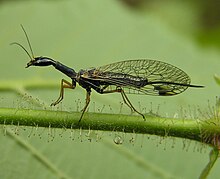The Insects Portal


Insects (from Latin insectum) are hexapod invertebrates of the class Insecta. They are the largest group within the arthropod phylum. Insects have a chitinous exoskeleton, a three-part body (head, thorax and abdomen), three pairs of jointed legs, compound eyes, and a pair of antennae. Insects are the most diverse group of animals, with more than a million described species; they represent more than half of all animal species. (Full article...)
Selected article -
Snakeflies are a group of predatory insects comprising the order Raphidioptera with two extant families: Raphidiidae and Inocelliidae, consisting of roughly 260 species. In the past, the group had a much wider distribution than it does now; snakeflies are found in temperate regions worldwide but are absent from the tropics and the Southern Hemisphere. Recognisable representatives of the group first appeared during the Early Jurassic. They are a relict group, having reached their apex of diversity during the Cretaceous before undergoing substantial decline.
An adult snakefly resembles a lacewing in appearance but has a notably elongated thorax which, together with the mobile head, gives the group their common name. The body is long and slender and the two pairs of long, membranous wings are prominently veined. Females have a large and sturdy ovipositor which is used to deposit eggs in some concealed location. They are holometabolous insects with a four-stage life cycle consisting of eggs, larvae, pupae and adults. In most species, the larvae develop under the bark of trees. They may take several years before they undergo metamorphosis, requiring a period of chilling before pupation takes place. Both adults and larvae are predators of soft-bodied arthropods. (Full article...)
Did you know -
- ... that the cicada Aleeta curvicosta of eastern Australia is known as the floury baker from its appearance of being dusted with white powder?
- ... that a blister beetle was introduced in Hawaii to trim the wood-boring Sonoran carpenter bee population, but the beetle failed to survive in the islands?
- ... that the termite Globitermes sulphureus uses autothysis, a form of suicidal altruism, to entangle intruder ants in a sticky substance?
- ... that male Coastal Petaltails have unique, bright orange anal appendages called 'petaltails' that are believed to be used to attract a mate?
- ... that some beetles of the genus Zopherus are used as living brooches?
List articles
Related portals
General images -
Selected image -

Mayflies (subimago of Rhithrogena germanica pictured) comprise around 2,500 species of insects which belong to the Order Ephemeroptera. They are aquatic insects whose immature stage usually lasts one year in fresh water, while the adults are short-lived, surviving from a few minutes to a few days.
WikiProjects

Main WikiProject:
Related projects:
- WikiProject Arthropods
- WikiProject Spiders
- WikiProject Animals
- WikiProject Tree of Life
- WikiProject Biology
Daughter projects:
Tasks
 |
Here are some tasks awaiting attention:
|
Associated Wikimedia
The following Wikimedia Foundation sister projects provide more on this subject:
-
Commons
Free media repository -
Wikibooks
Free textbooks and manuals -
Wikidata
Free knowledge base -
Wikinews
Free-content news -
Wikiquote
Collection of quotations -
Wikisource
Free-content library -
Wikiversity
Free learning tools -
Wiktionary
Dictionary and thesaurus



















































